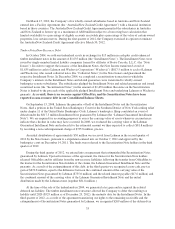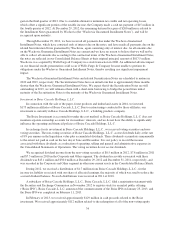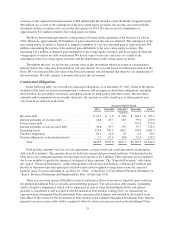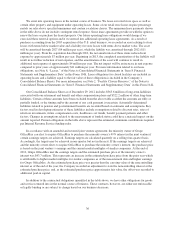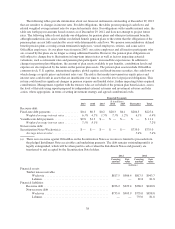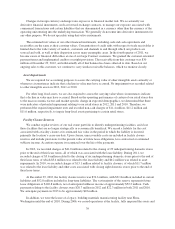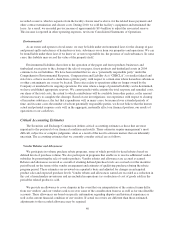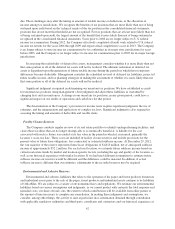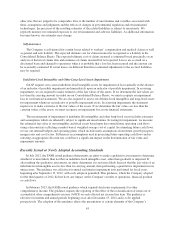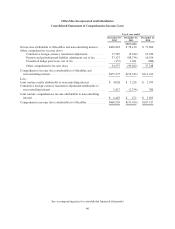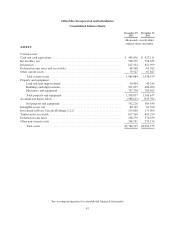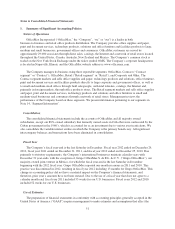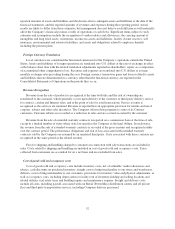OfficeMax 2012 Annual Report Download - page 79
Download and view the complete annual report
Please find page 79 of the 2012 OfficeMax annual report below. You can navigate through the pages in the report by either clicking on the pages listed below, or by using the keyword search tool below to find specific information within the annual report.other sites that are judged to be comparable. Due to the number of uncertainties and variables associated with
these assumptions and judgments and the effects of changes in governmental regulation and environmental
technologies, the precision of the resulting estimates of the related liabilities is subject to uncertainty. We
regularly monitor our estimated exposure to our environmental and asbestos liabilities. As additional information
becomes known, our estimates may change.
Self-insurance
The Company is self-insured for certain losses related to workers’ compensation and medical claims as well
as general and auto liability. The expected ultimate cost for claims incurred is recognized as a liability in the
Consolidated Balance Sheets. The expected ultimate cost of claims incurred is estimated based principally on an
analysis of historical claims data and estimates of claims incurred but not reported. Losses are accrued on a
discounted basis and charged to operations when it is probable that a loss has been incurred and the amount can
be reasonably estimated. If actual losses are different than those estimated adjustments to the accrued liabilities
may be required.
Indefinite-Lived Intangibles and Other Long-Lived Assets Impairment
GAAP requires us to assess indefinite-lived intangible assets for impairment at least annually in the absence
of an indicator of possible impairment and immediately upon an indicator of possible impairment. In assessing
impairment, we are required to make estimates of the fair values of the assets. If we determine the fair values are
less than the carrying amount recorded on our Consolidated Balance Sheets, we must recognize an impairment
loss in our financial statements. We are also required to assess our definite-lived intangibles and long-lived assets
for impairment whenever an indicator of possible impairment exists. In assessing impairment, the statement
requires us to make estimates of the fair values of the assets. If we determine the fair values are less than the
carrying values of the assets, we must recognize an impairment loss in our financial statements.
The measurement of impairment of indefinite life intangibles and other long-lived assets includes estimates
and assumptions which are inherently subject to significant uncertainties. In testing for impairment, we measure
the estimated fair value of our intangibles and fixed assets based upon discounted future operating cash flows
using a discount rate reflecting a market-based, weighted average cost of capital. In estimating future cash flows,
we use our internal budgets and operating plans, which include many assumptions about future growth prospects,
margin rates and cost factors. Differences in assumptions used in projecting future operating cash flows and in
selecting an appropriate discount rate could have a significant impact on the determination of fair value and
impairment amounts.
Recently Issued or Newly Adopted Accounting Standards
In July 2012, the FASB issued guidance that permits an entity to make a qualitative assessment to determine
whether it is more likely than not that an indefinite-lived intangible asset, other than goodwill, is impaired. If,
after making the qualitative assessment, an entity determines it is not more likely than not that the fair value of an
indefinite-lived intangible asset is less than its carrying amount, then performing a quantitative impairment test is
unnecessary. The guidance was effective for annual and interim impairment tests performed for fiscal years
beginning after September 15, 2012, with early adoption permitted. This guidance, which the Company adopted
for the third quarter of 2012, did not have any impact on the Company’s results of operations, financial position
or cash flows.
In February 2013, the FASB issued guidance which expands disclosure requirements for other
comprehensive income. The guidance requires the reporting of the effect of the reclassification of items out of
accumulated other comprehensive income (AOCI) on each affected net income line item. The guidance is
effective for interim and annual periods beginning on or after December 15, 2012 and is to be applied
prospectively. The adoption of this guidance affects the presentation of certain elements of the Company’s
43


